-
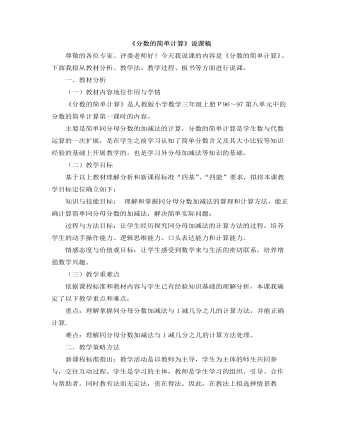
小学数学人教版三年级上册《分数的简单计算》说课稿
一.教材分析(一)教材内容地位作用与学情《分数的简单计算》是人教版小学数学三年级上册P96~97第八单元中的分数的简单计算第一课时的内容。主要是简单同分母分数的加减法的计算,分数的简单计算是学生数与代数运算的一次扩展,是在学生之前学习认知了简单分数含义及其大小比较等知识经验的基础上开展教学的。也是学习异分母加减法等知识的基础。(二)教学目标基于以上教材理解分析和新课程标准“四基”、“四能”要求,拟将本课教学目标定位确立如下:知识与技能目标: 理解和掌握同分母分数加减法的算理和计算方法,能正确计算简单同分母分数的加减法,解决简单实际问题;过程与方法目标:让学生经历探究同分母加减法的计算方法的过程。培养学生的动手操作能力、逻辑思维能力、口头表达能力和计算能力。情感态度与价值观目标:让学生感受到数学来与生活的密切联系,培养增强数学兴趣。
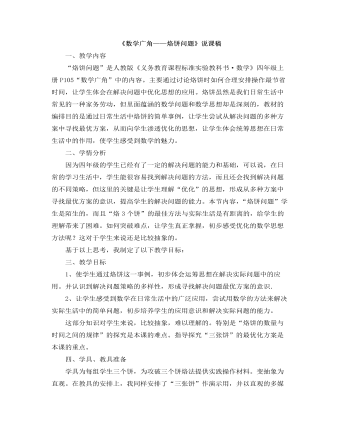
小学数学人教版四年级上册《数学广角——烙饼问题》说课稿
第一个板块是“脑筋急转弯”,激发学习兴趣。目的有两个:一是拉近与学生的距离,二是为本节课做铺垫。第二板块是自主探究,优化策略。这一部分内容通过“操作感悟——抽象内化——巩固应用”三个片段,使学生在教师的点拨引导下,沿以下四个步骤:“一张和两张饼的烙法(基础)→三张饼的最佳烙法(难点)→双数饼、单数饼的烙法(提升)→最佳方案、双数饼:两张两张烙;单数饼:两张两张烙+最后3张饼交叉烙(优化)进行探究。1、探索烙3张饼的最少时间是本节课的重点也是难点,优化的数学思想只能是“渗透”而不能“明透”,也就是说只能让学生在潜移默化的过程中理解,而不能仅仅靠传授。因此,本课中蓄势----为探索最佳方法打基础的方法,自认为运用得恰到好处。例如,围绕“烙2张饼最少要花6分,为什么烙1张饼与2张饼所用的时间一样多呢?你们是怎么想的?”这个问题,让学生体会烙2张饼是用足了空间,而烙1张饼浪费了空间和时间,为探索烙3张饼埋下了伏笔。
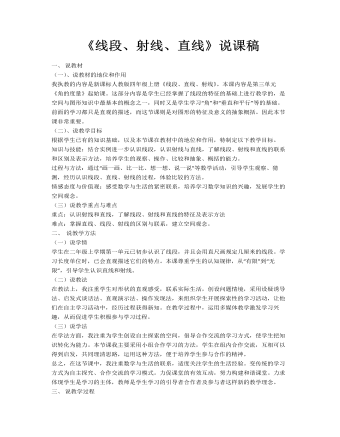
小学数学人教版四年级上册《线段、射线、直线》说课稿
(一)情境导入以鲜明的色彩、生动的画面演绎激光从地球发送到月球的全过程,既引出了学过的线段,又激发学生探究新知的欲望。(二) 质疑探究在讲授新课的过程中,我选择了多媒体的教学手段。这些教学手段的运用可以使抽象的知识具体化,枯燥的知识生动化,乏味的知识兴趣化。1、认识线段。通过多媒体演绎,使学生对于抽象的“线段”的认识建立在具体的生活模型基础上,有助于学生认识图形特征,形成表象,感受生活中处处有数学。这一环节主要引导学生回顾所学的线段知识,通过画图、说特征、举例子、讲授字母表示法这一系列活动,使学生进一步认识线段。2、 认识射线。多媒体课件形象、生动地演示了激光在宇宙中不断延长,再延长,通过直观感知,在头脑中建立“无限延长”的表象,帮助学生理解“无限延长”的含义。通过教师引导和小组合作,共同学习射线的画法、特征及字母表示法,进而把所学知识还原到生活当中,让学生明确数学与生活紧密联系。
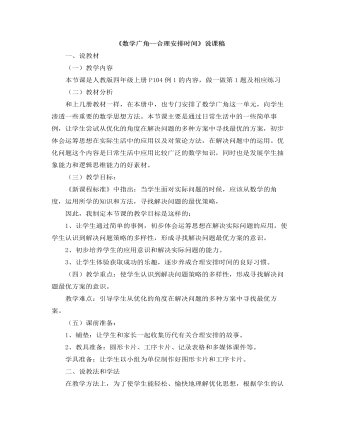
小学数学人教版四年级上册《数学广角——合理安排时间》说课稿
(五)课前准备: 1、铺垫:让学生和家长一起收集历代有关合理安排的故事。 2、教具准备:圆形卡片、工序卡片、记录表格和多媒体课件等。 学具准备:让学生以小组为单位制作好图形卡片和工序卡片。 二、说教法和学法 在教学方法上,为了使学生能轻松、愉快地理解优化思想,根据学生的认知特点和规律,在本课的设计中,我使用了演示法和实验法,通过课件的情境演示和实物的操作为学生创设情境,让学生独立思考,然后动手操作,互相交流,最后找出最优方案的方式组织教学。 在学法方面,我设计了一系列贴近学生生活实际和年龄特点的教学活动,在这些活动中,着重以引导学生运用自主探究、合作探究两种学习方式交替学习,让他们真正以课堂的身份参与全程。并培养他们收集数据和分析处理数据的能力。
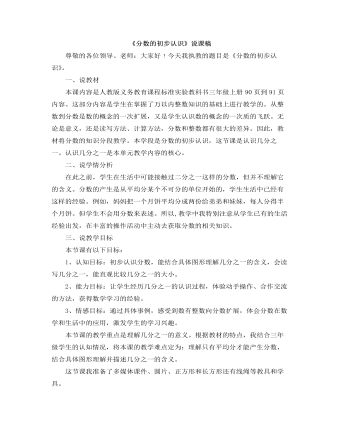
小学数学人教版三年级上册《分数的初步认识》说课稿
一、说教材本课内容是人教版义务教育课程标准实验教科书三年级上册90页到91页内容。这部分内容是学生在掌握了万以内整数知识的基础上进行教学的。从整数到分数是数的概念的一次扩展,又是学生认识数的概念的一次质的飞跃。无论是意义,还是读写方法、计算方法,分数和整数都有很大的差异。因此,教材将分数的知识分段教学。本学段是分数的初步认识,这节课是认识几分之一。认识几分之一是本单元教学内容的核心。二、说学情分析在此之前,学生在生活中可能接触过二分之一这样的分数,但并不理解它的含义。分数的产生是从平均分某个不可分的单位开始的,学生生活中已经有这样的经验。例如,妈妈把一个月饼平均分成两份给弟弟和妹妹,每人分得半个月饼。但学生不会用分数来表述。所以,教学中我特别注意从学生已有的生活经验出发,在丰富的操作活动中主动去获取分数的相关知识。
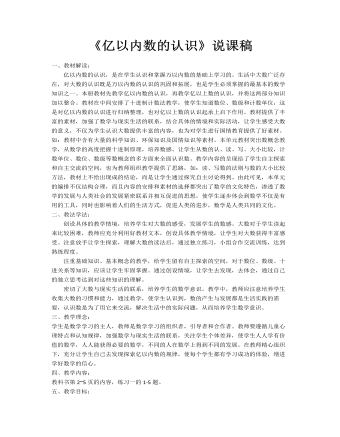
小学数学人教版四年级上册《亿以内数的认识》说课稿
三、教学理念:学生是数学学习的主人,教师是数学学习的组织者,引导者和合作者。教师要遵循儿童心理特点和认知规律,加强数学与现实生活的联系,关注学生个体差异,使学生人人学有价值的数学,人人能获得必要的数学,不同的人在数学上得到不同的发展。在教师精心组织下,充分让学生自己去发现探索亿以内数的规律,使每个学生都有学习成功的体验,增进学好数学的信心。四、教学内容:教科书第2~5页的内容,练习一的1-5题。五、教学目标:1.使学生认识计数单位"万""十万""百万""千万"和"亿",知道亿是个大数;知道亿以内各计数单位的名称和相邻两个单位之间的十进关系。2.掌握数位顺序,理解并掌握我国四位一级的计数习惯,能够根据数级正确地读出亿以内的数。3.通过情境创设,小组合作学习等形式,使学生获得正确读数的成功体验;培养学生分析、综合的能力。4.培养学生对大数的感受,发展学生的数感。六、教学重点:亿以内数的认识,读法。七、教学难点:1. 数级、数位、计数单位的区别以及"位值"的理解。2.每级中间或末尾有0的读法。八、教具学具:教师准备PPT课件,数位表,师生都备计数器。
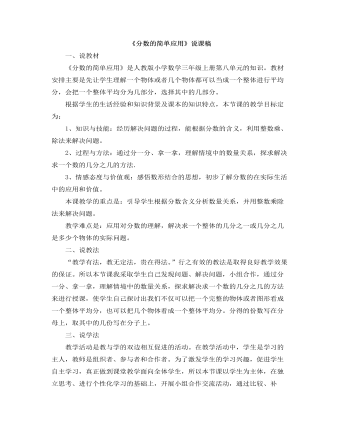
小学数学人教版三年级上册《分数的简单应用》说课稿
一、说教材《分数的简单应用》是人教版小学数学三年级上册第八单元的知识。教材安排主要是先让学生理解一个物体或者几个物体都可以当成一个整体进行平均分,会把一个整体平均分为几部分,选择其中的几部分。根据学生的生活经验和知识背景及课本的知识特点,本节课的教学目标定为:1、知识与技能:经历解决问题的过程,能根据分数的含义,利用整数乘、除法来解决问题。2、过程与方法:通过分一分、拿一拿,理解情境中的数量关系,探求解决求一个数的几分之几的方法.3、情感态度与价值观:感悟数形结合的思想,初步了解分数的在实际生活中的应用和价值。本课教学的重点是:引导学生根据分数含义分析数量关系,并用整数乘除法来解决问题。
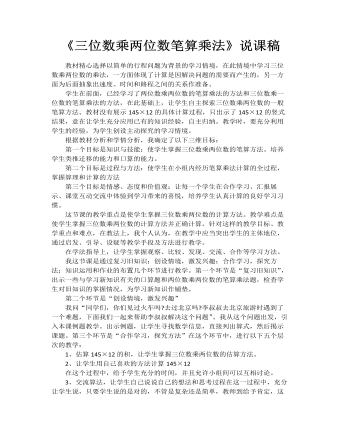
小学数学人教版四年级上册《三位数乘两位数笔算乘法》说课稿
根据教材分析和学情分析,我确定了以下三维目标:第一个目标是知识与技能:使学生掌握三位数乘两位数的笔算方法。培养学生类推迁移的能力和口算的能力。第二个目标是过程与方法:使学生在小组内经历笔算乘法计算的全过程,掌握算理和计算的方法第三个目标是情感、态度和价值观:让每一个学生在合作学习、汇报展示、课堂互动交流中体验到学习带来的喜悦,培养学生认真计算的良好学习习惯。这节课的教学重点是使学生掌握三位数乘两位数的计算方法。教学难点是使学生掌握三位数乘两位数的计算方法并正确计算。针对这样的教学目标、教学重点和难点,在教法上,我个人认为,在教学中应当突出学生的主体地位,通过启发、引导、设疑等教学手段及方法进行教学。
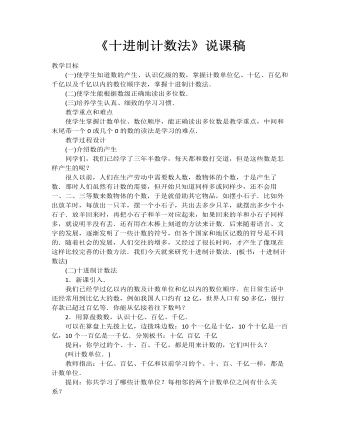
小学数学人教版四年级上册《十进制计数法》说课稿
(二)十进制计数法1.新课引入.我们已经学过亿以内的数及计数单位和亿以内的数位顺序.在日常生活中还经常用到比亿大的数,例如我国人口约有12亿,世界人口有50多亿,银行存款已超过百亿等.你能从亿接着往下数吗?2.用算盘数数,认识十亿、百亿、千亿.可以在算盘上先拨上亿,边拨珠边数:10个一亿是十亿,10个十亿是一百亿,10个一百亿是一千亿.分别板书:十亿 百亿 千亿提问:你学过的个、十、百、千亿,都是用来计数的,它们叫什么?(叫计数单位.)教师指出:十亿、百亿、千亿和以前学习的个、十、百、千亿一样,都是计数单位.
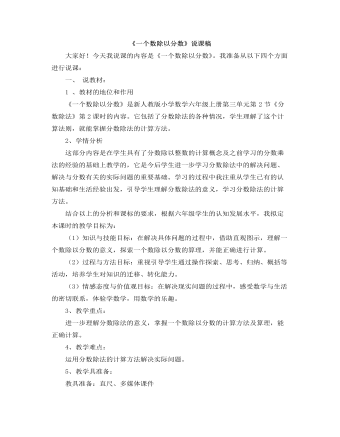
小学数学人教版六年级上册《一个数除以分数》说课稿
二、说教法、学法:根据本节课的教学目标。重点、难点设置,我确定本节课的教法与学法: 我国教育家叶圣陶先生曾经说过“教师教任何功课,‘讲’都是为了达到用不着‘讲’,‘教’都是为了达到用不着‘教’”,这一精辟结论强调了教师要教会学生如何学习,让学生一辈子受用。为突出重点,分散难点,始终使学生参与知识形成的过程。引导学生将“图”与“式”对照起来,进行分析和说理。从而在发挥直观形象思维对于抽象逻辑思维支持作用的同时,让学生逐渐感受数形结合的优势。根据高年级学生已具有处理信息和自主学习的能力,我设计了4个教学环节。教学中通过学生观察、分析、讨论、合作等方式,引导学生寻找计算方法,并通过发现、总结、运用法则调动学生的积极性。
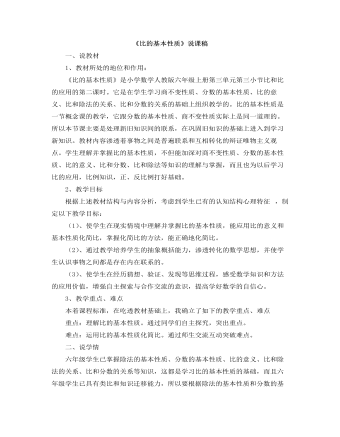
小学数学人教版六年级上册《比的基本性质》说课稿
一、说教材1、教材所处的地位和作用:《比的基本性质》是小学数学人教版六年级上册第三单元第三小节比和比的应用的第二课时。它是在学生学习商不变性质、分数的基本性质、比的意义、比和除法的关系、比和分数的关系的基础上组织教学的。比的基本性质是一节概念课的教学,它跟分数的基本性质、商不变性质实际上是同一道理的。所以本节课主要是处理新旧知识间的联系,在巩固旧知识的基础上进入到学习新知识。教材内容渗透着事物之间是普遍联系和互相转化的辩证唯物主义观点。学生理解并掌握比的基本性质,不但能加深对商不变性质、分数的基本性质、比的意义、比和分数、比和除法等知识的理解与掌握,而且也为以后学习比的应用,比例知识,正、反比例打好基础。
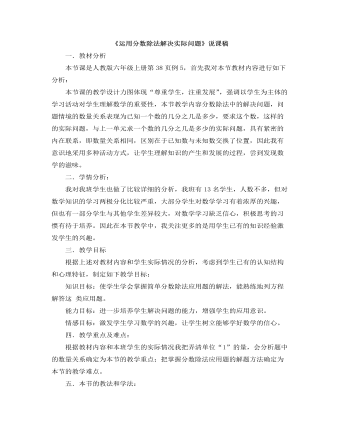
小学数学人教版六年级上册《运用分数除法解决实际问题》说课稿
一.教材分析本节课是人教版六年级上册第38页例5,首先我对本节教材内容进行如下分析:本节课的教学设计力图体现“尊重学生,注重发展”,强调以学生为主体的学习活动对学生理解数学的重要性,本节教学内容分数除法中的解决问题,问题情境的数量关系表现为已知一个数的几分之几是多少,要求这个数,这样的的实际问题,与上一单元求一个数的几分之几是多少的实际问题,具有紧密的内在联系,即数量关系相同,区别在于已知数与未知数交换了位置,因此我有意识地采用多种活动方式,让学生理解知识的产生和发展的过程,尝到发现数学的滋味。 二.学情分析:我对我班学生也做了比较详细的分析,我班有13名学生,人数不多,但对数学知识的学习两极分化比较严重,大部分学生对数学学习有着浓厚的兴趣,但也有一部分学生与其他学生差异较大,对数学学习缺乏信心,积极思考的习惯有待于培养。因此在本节教学中,我关注更多的是用学生已有的知识经验激发学生的兴趣。
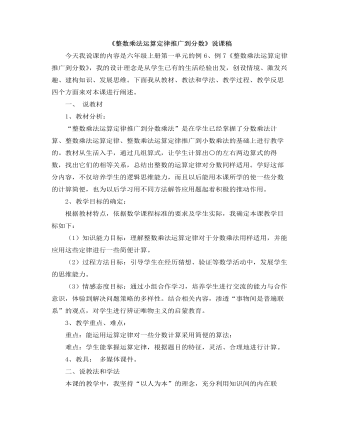
小学数学人教版六年级上册《整数乘法运算定律推广到分数》说课稿
今天我说课的内容是六年级上册第一单元的例6、例7《整数乘法运算定律推广到分数》,我的设计理念是从学生已有的生活经验出发,创设情境、激发兴趣、建构知识、发展思维。下面我从教材、教法和学法、教学过程、教学反思四个方面来对本课进行阐述。一、 说教材1、教材分析:“整数乘法运算定律推广到分数乘法”是在学生已经掌握了分数乘法计算、整数乘法运算定律、整数乘法运算定律推广到小数乘法的基础上进行教学的。教材从生活入手,通过几组算式,让学生计算出○的左右两边算式的得数,找出它们的相等关系,总结出整数的运算定律对分数同样适用。学好这部分内容,不仅培养学生的逻辑思维能力,而且以后能用本课所学的使一些分数的计算简便,也为以后学习用不同方法解答应用题起着积极的推动作用。
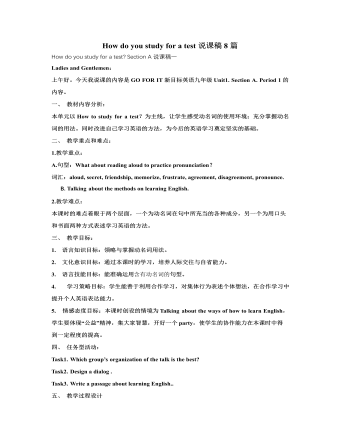
人教版新目标初中英语九年级上册How do you study for a test说课稿8篇
教学反思:这是学生升入初三的第一节课,学生学习热情很高,通过这一课时的学习,学生掌握了语言目标中所要求的知识重点、难点和语言技能,如by dong, practicing doing ,too……to,现在完成时态,动名词短语做主语及提建议的几种方式,但是有部分学生由于基础较差,还需要从培养学生学习兴趣入手,真正实现教育面向全体学生。在教学中采取的具体办法由:个别辅导,互助学习,留不同层次夫人作业,争取让每一位学生都吃饱而不掉队。How do you study for a test?Two periodsSection BGoals●To listen about learning English●To talk about learning English●To read about learning EnglishProceduresWarming up by reading to the recordingHello, everyone. To begin with, let’s listen and read to the recording of the text HOW DO YOU LEARN BEST? That is, read aloud to the tape, as fast as the tape goes, as clearly as the native reader reads. OK? Here we go!My cat speaks English. Sometimes my cat comes to me and tells me that she is hungry. Or that her leg hurts. How does my cat tell me these things? I don't speak pussy-cat language.1a Reading and checkingLearning English can be both easy and difficult. What things are easy for you? And what things are difficult for you? Now turn to page 5, read the list on the top and check √the statements that are true for you.1b Making a listYou have read and checked the statements true for you. Now think and make a list of other things difficult for you, too.
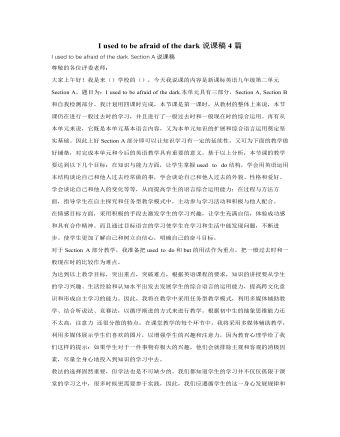
人教版新目标初中英语九年级上册I used to be afraid of the dark说课稿4篇
2、说说写写通过读写训练,进一步学会用 used to 结构来表达自己和同伴过去害怕,或现在仍旧害怕的事情,并且要把最后的结果书写下来,然后让他们将结果用英语告之其他同学,为学生创造展示才能的机会。这样能使全体同学都积极参与,集中精力认真听。既巩固了本节课的目标语言,又为下一个环节3b的对话打下基础。活动结问题比较容易,英语基础较差的学生也能够独立完成,因此,在检查答案是尽量让这部分学生回答,使他们体验到成功后的喜悦,提高他们学习英语的兴趣。 3.对话练习:让学生两人一组,模仿3a中的对话,根据提供的信息与提示词进行对话练习,目的在于对新学的目标语言进行口头练习与设定情景中的运用。为学生创造展示才能的机会。推荐两至三组的同学到教室前面,就所编的对话进行角色表演。
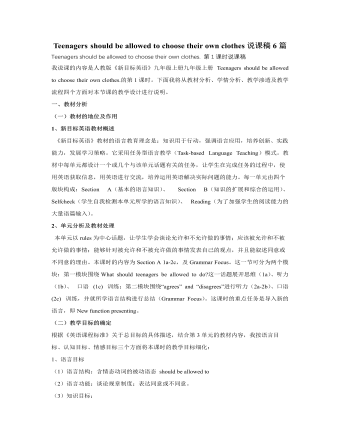
人教版新目标初中英语九年级上册Teenagers should be allowed to choose their own clothes说课稿6篇
二、教材分析本课时主要是以听和说的方式来谈论一些家庭和学校的“规矩和制度”,知道那些时可以做的,那些是不可以做的,让学生先从口头上了解这些规矩和制度,为后面的学习做好准备。三、教学的目的和要求1. 掌握短语be strict with sb.的用法,并介绍be strict in sth.的用法;2. 学生能够根据所学的知识,了解用什么方式/句型来制定规章制度。3. 多听,提高学生的习愿望,敦促学生开口说英语,用本课所学的知识来表达自己的意见。四、教学重点和难点1. 如何正确使用be allowed to do…这一句型(在不同时态中的被动语态运用)。2. 如何获得听力技巧及口语技能的提高。五、教学过程T—teacher S—studentS s—students Bb—blackboardStep 1 Warming up Check their homework first, and see if the Ss can make sentences by using the rules in 4, Section A. If possible, try to give some help.
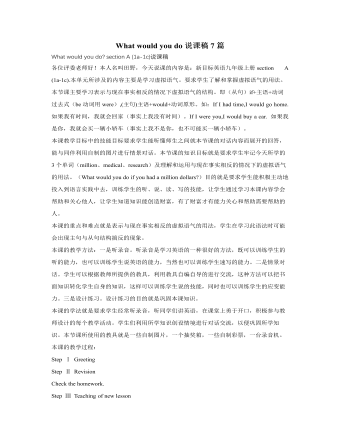
人教版新目标初中英语九年级上册What would you do说课稿7篇
Get students to complete the activity in groups of four. As the groups work together, move around the room to make sure students discuss the topic in English and know how to fill in the chart.Check the answers by asking different pairs of students to say their conversations to the class.Answers will vary.Optional activityAsk, What would you do if there were no classes tomorrow? Ask students to write as many answers as they can. Then get students to work in pairs. One ask the other the question and see how many new answers the other is able to think of.Step Ⅴ SummarySay, In this class, we've done a lot of reading, speaking and writing practice using the target language.Step Ⅵ Homework(1) Review the target language by reading the conversations in Activity 3a.(2) Finish off the exercises on pages 11~12 of the workbook.Step Ⅶ Blackboard DesignWhat would you do?Section AThe Third PeriodTarget language:A: I can't sleep the night before an exam. Then I'm too tired to do well. What should I do?B: If I were you, I'd take a long walk before going to bed. That should help you relax.A: I really want a dog, but my parents won't let me have one.B: Well, dogs can be a lot of trouble. Maybe you should get a small pet, like a goldfish.A: That's a good idea.

小学数学人教版一年级上册《6、7加减法的应用》说课稿
说课内容:我说课的内容是人教版小学数学一年级上册第五单元、第三课时、6、7的加减法应用。我将从教材分析,教学目标分析,教学重难点及突破方法,教学流程设计,4个方面来进行说课。一、说教材:1、内容:本节课是在学生学习6、7加减法的基础上展开教学的,教材第一次出现用情景图呈现数学问题的形式,呈现了一个简单求和求差的数学问题,使学生明确、知道两个相关的信息和一个相关的问题,就构成了一个简单的数学问题。2、地位:从整个知识网络来看,它也标志着数学应用题数学的开始,是向后面的文字应用题过度的桥梁。二、说教学目标通过对教材的分析,确立了如下教学目标:1.通过学习使学生认识理解大括号和问号的意义,能借助图画正确分析题意。2.会用6和7的加减法解决生活中简单问题,使学生切实感受到用学过的数学知识去解决简单的实际问题的过程。3.初步感受数学与日常生活的密切联系,体验学数学、用数学的乐趣。
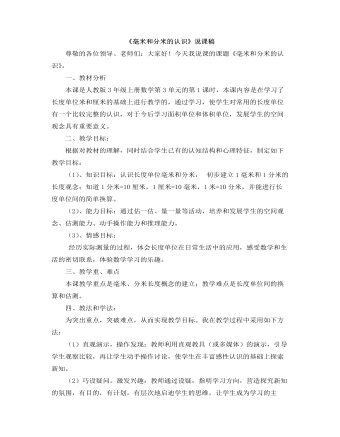
小学数学人教版三年级上册《毫米和分米的认识》说课稿
一、教材分析本课是人教版3年级上册数学第3单元的第1课时,本课内容是在学习了长度单位米和厘米的基础上进行教学的,通过学习,使学生对常用的长度单位有一个比较完整的认识,对于今后学习面积单位和体积单位,发展学生的空间观念具有重要意义。二、教学目标:根据对教材的理解,同时结合学生已有的认知结构和心理特征,制定如下教学目标:(1)、知识目标:认识长度单位毫米和分米, 初步建立1毫米和1分米的长度观念;知道1分米=10厘米,1厘米=10毫米,1米=10分米,并能进行长度单位间的简单换算。(2)、能力目标:通过估一估、量一量等活动,培养和发展学生的空间观念、估测能力、动手操作能力和推理能力。(3)、情感目标:经历实际测量的过程,体会长度单位在日常生活中的应用,感受数学和生活的密切联系,体验数学学习的乐趣。
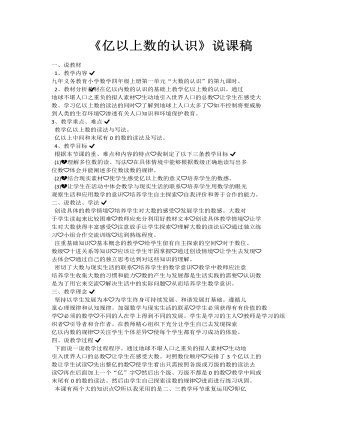
小学数学人教版四年级上册《亿以上数的认识》说课稿
一、说教材 1、教学内容 九年义务教育小学数学四年级上册第一单元“大数的认识”的第九课时。 2、教材分析教材在亿以内数的认识的基础上教学亿以上数的认识。通过地球不堪人口之重负的拟人素材生动地引入世界人口的总数让学生在感受大数、学习亿以上数的读法的同时了解到地球上人口太多了如不控制将要威胁到人类的生存环境渗透有关人口知识和环境保护教育。 3、教学重点、难点 教学亿以上数的读法与写法。 亿以上中间和末尾有0的数的读法及写法。 4、教学目标 根据本节课的重、难点和内容的特点我制定了以下三条教学目标 (1)理解多位数的读、写法在具体情境中能够根据数级正确地读写出多位数体会并能阐述多位数读数的规律。 (2)结合现实素材使学生感受亿以上数的意义培养学生的数感。 (3)让学生在活动中体会数学与现实生活的联系培养学生用数学的眼光观察生活和应用数学的意识培养学生自主探索自我评价和善于合作的能力。

